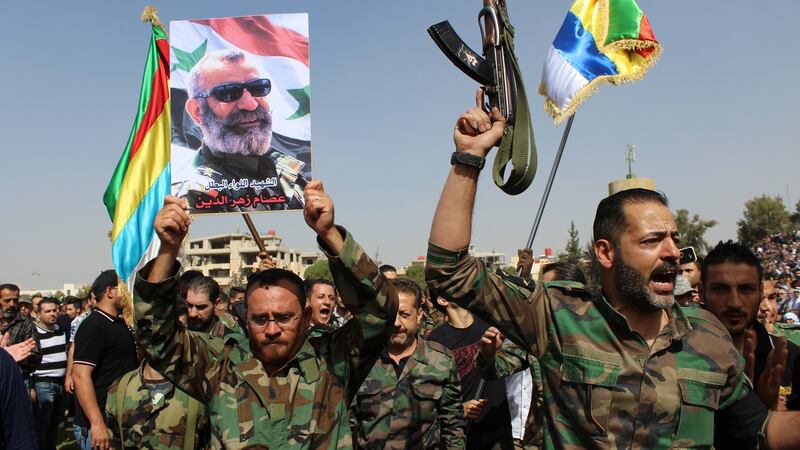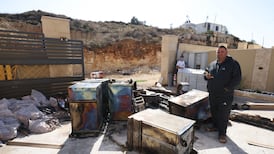Deir al-Zor is at the end of the world. The journey is six hours by road from the city of Homs through its green belt of orchards and gardens narrowed by more than six years of war and enforced neglect.
As the desert engulfs farms, olive trees are shrivelled and irrigation pipes curl like discarded snake-skins across the soil.
At army checkpoints, soldiers seek shade in shelters made of empty ammunition boxes roofed by canvas. Black smoke rises from a burning well in a natural gas field. On the right, Palmyra’s hill-top castle stands sentinel against the faded blue sky followed by the iconic columns of the 2,000-year-old ruins of the once prosperous city state.
Rulers have routinely risen and fallen since civilisation rose here. This time the cruel Islamic State (Isis) “caliphate” of Abu Bakr al-Baghdadi is on the skids.
On the tops of hills on the right, government soldiers camp along the dotted line that defends the road from Baghdadi’s remaining fighters. We are passing along the edge of “Isis country”.
Gutted cars and vans on the verges testify to their desperate bids to remain relevant while the Syrian army and its allies and US-backed Kurdish forces squeeze them from pockets of land. Islamic State no longer imposes its brutal rule on entire cities and has been reduced to eastern Deir al-Zor, capital of the province of the same name.
Civilians remain
In early September, the Syrian army broke Islamic State’s siege of government-held western districts of the city, the garrison, and air field. Since then the army has driven the jihadis from additional neighbourhoods. At mid-afternoon soldiers seem to be the only residents of the dusty, dun-coloured city. Among the damaged, windowless houses and flats, laundry hanging on balconies shows that civilians remain.
Since no hotels are open, our billet is a doctor’s four-bedroom villa on a shady street of depreciating villas. We had been told there is no food, water or petrol in Deir al-Zor. We stocked up and and found everything, although fuel is still in short supply.
At a meeting in his swank office, governor Mohamed Ibrahim Samra says that, during the 1,000-day siege, the city's infrastructure was destroyed. There is no electricity, and water is in short supply.
But there has been progress. “There are 10,000 students in school. We provide books, everything. Food reaches the markets. Medicines are supplied by the Syrian Red Crescent and the WHO [World Health Organisation].
“There are now 70,000 people in the city. Before the war there were 350,000 and 1.7 million in the province. Ninety per cent of the province was under [Islamic State].”
Deafening roar
I doubt his figure for the number of civilians remaining until visiting the souq, which is packed with people shopping or gawking, celebrating, meeting friends. The clack of generators and roar of motorbikes is deafening.
Pharmacist Ayman Diab and his wife survived the siege. The insurgent Free Syrian Army and al-Qaeda’s Jabhat al-Nusra brought the war to Deir al-Zor but were pushed out by Syrian, Tunisian, Afghan, Saudi and Chechen fighters of Islamic State.

“They promised uneducated, poor people freedom and a good future,” Diab says. “Under the siege, some food and a few medicines were delivered by air. Since only 19 doctors remained out of 1,147, pharmacists did the work of doctors. Medicines were expired or could not be used due to the lack of refrigeration. Eyeglasses were impossible.
“We lost a lot of young men [in the army] and children to mortars. Children also died of malnourishment. Adults were weak due to the lack of food. We had only dry stuff, rice and burghul [cracked wheat ]and lentils.”
He proudly displays his current collection of unexpired medicines of German, Turkish, US, and British manufacture before entering a curtained stall at the back of the room to give a man an injection.
Today, food and medicines are brought in by lorry. Fruit, vegetables, meat and chicken are plentiful. Fathiye Moula Rashid, her pretty face framed by a soft grey headscarf, has just bought her daughter Raghed and son Ahmad chawarma (meat) sandwiches, but her youngest, who is two – born during the siege – refuses to eat and cannot speak properly due to malnourishment.
Family fortunate
Her family was fortunate as her husband, a water department employee, continued to work and receive his salary. “Water is better now,” she says, although the city’s main pumping station was bombed.
Another part of the souq is devoted to coffee houses where men are smoking water pipes while glued to television coverage of the life and times of General Issam Zahreddine, the beloved commander of operations here who had been killed by an improvised explosive device.

A white-bearded, larger-than-life character, the 55-year-old Zahreddine led his troops from the front, hugged and sang with the soldiers and led forces fighting in Homs and Aleppo before deployment here.
The flat, metallic snap of mortars and the thick boom of artillery wakes us at about 3.30am. Planes circle the city and bomb. At exactly 4.05am, my local mobile buzzes with a message from the tourism ministry welcoming me to Syria. The bombing continues through early morning prayers broadcast from a nearby mosque. "All outgoing and [all] ours," says a senior officer later.
Captured weapons
At an abandoned factory, the army displays thousands of weapons captured from Islamic State here and in the town of Mayadin, to the south. Rifles and machine guns are laid out in neat rows on the ground, drones are gathered on a ramp and boxes of ammunition are lifted from lorries – weapons of war from the world over in the hands of Islamic State.
Our last stop is the Euphrates river, gently flowing between green banks where soldiers guard the wrecked pumping station that once provided the city with water.
Shots and the thud of mortars from a village 2km to the east reminds us we are on the front line. Our officer guide remarks: “We are at the end of the end of the war.”













